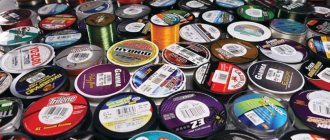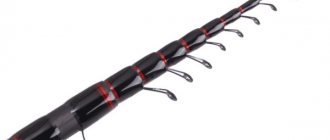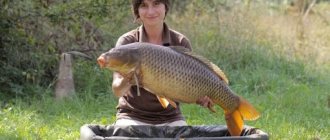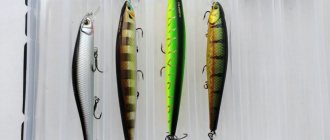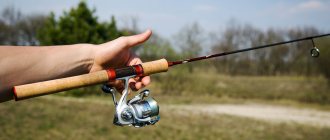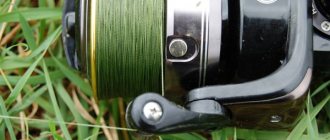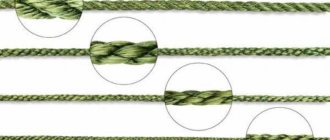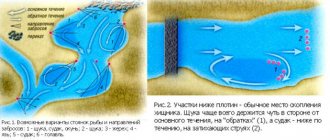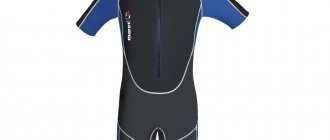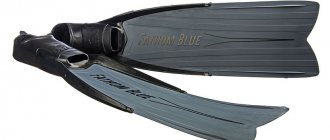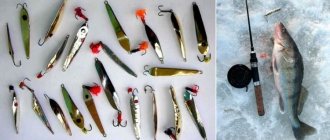A feeder rod is a rod for bottom fishing. The equipment of this fishing rod contains a distinctive element, which gave its name to the form, and at the same time to the method of fishing - the feeder.
This type of fishing rod was invented in the British Isles. They appeared in our lands in the early 90s of the twentieth century. They became widespread already in the 2000s.
Externally, this type of fishing rod resembles a modern spinning rod. The form is equipped with pass rings. The handle is most often made of cork. There is a reel seat on the lower leg. The marking is applied to the same lower knee.
The classic feeder is a prefabricated structure. It consists of three elbows, which are mounted via a plug connection. However, in fishing stores you can find telescopic type feeder rods, as well as hybrids suitable for both feeder and match fishing.
A distinctive feature of any feeder from another type of form is a replaceable tip, which is called a quiver tip and is a bite alarm.
Any feeder rod kit always includes a small tube containing at least three interchangeable tips, which are distinguished by color and hardness.
The feeder can be used both for fishing in currents and for fishing in calm water bodies. This type is mainly used for catching peaceful fish.
Photo 1. Replacement tips for the feeder
How to choose a feeder
Theoretically, you can buy the first feeder you like at a fishing store, and then try to adapt it to the fishing conditions. But you can act more effectively - collect preliminary information about your favorite body of water. In any case, information is never superfluous.
It is necessary to at least approximately imagine the body of water where you will most often fish with the help of a feeder. The meaning may be:
- size of the reservoir;
- the nature of the bottom (edges, tables, holes, pools, etc. and the approximate distances to them);
- fish living in the reservoir (fish breeds and their sizes).
This data will help in choosing a feeder when there is a need to compare the technical characteristics of forms.
Feeder characteristics
Like any other fishing rod, a feeder blank can be characterized based on:
- The material that was used to make the fishing rod.
- Form lengths.
- Testa.
These indicators are interdependent. Their combination determines the strength characteristics, casting range and accuracy of feeders of various weights, as well as the price of the form.
Feeder rod length
The length of the rod can play a big role in reservoirs with very strong currents and side winds. For example, we fish in a deep river with a strong current, and when casting, even very heavy baits are carried away by the current. What should you do in this case? Raise the feeder rod as high as possible, because the less fishing line or cord is in the water, the less pressure the current creates on the fishing line or cord, and the feeder will not be washed away.
In this case, the length of the rod plays an important role. Approximately the same tactics can be used in strong winds. If there is no current on the reservoir, but a strong side wind is blowing, on the contrary, it is worth lowering the feeder as low as possible, almost to the water. This way the entire line will be under water and the wind pressure will be minimal.
Material
The following materials are used for the production of feeder rods:
- Fiberglass or fiberglass;
- Carbon fiber materials or modified carbon;
- Composite materials that combine the properties of glass and carbon fibers.
Fishing rods made from different materials have different qualities, such as weight, flexibility, strength, and price. But it is impossible to say unequivocally that forms made from any material are better. A feeder is a tool for catching fish. And each tool has its own purpose.
This is where you will need information about the reservoir, which should have been collected in advance.
Photo 2. Such different feeders!
Fiberglass rods
The main advantages of this material:
- strength;
- shock-absorbing qualities;
- price.
The only drawback is its own weight. It is invisible if you have to catch large, strong fish, which, by definition, bite quite rarely: carp, barbel, carp, catfish.
Carbon fiber blanks
The main advantage of this material is its low dead weight. These fishing rods are durable and reliable. Most manufacturers use these materials to make forms.
But the material has one significant drawback - electrical conductivity. It’s not for nothing that manufacturers warn that fishing with a carbon fiber fishing rod is prohibited during thunderstorms and under power lines.
In reservoirs where fish rarely reach trophy sizes and the bite is quite active, rods made of carbon fiber materials are indispensable.
Rods made of composite materials
Feeder forms made of composite materials are rarely found on sale.
Conclusion:
- for catching large fish that rarely bite, it is better to use fiberglass blanks;
- For dynamic fishing with a good bite from medium-sized fish, it is better to purchase a modified carbon fiber rod.
Photo 3. Powerful composite feeder.
Feeder rod structure
The build can be fast or slow. Slow action rods are also called parabolic rods, since the rod bends into an arc that strongly resembles a parabola. That is, the action can also be described by the ability of the rods to resist bending.
According to their rigidity, feeder rods are:
- hard;
- average;
- soft.
The softer the rod, the more it bends.
Rod elasticity is the actual speed at which the feeder rod straightens after the load is removed.
That is, the more elastic the rod, the faster it straightens; such models are called fast.
Form length
Since childhood, every fisherman knows that long casting is easier with a long rod. In feeder fishing, theoretically, this rule also applies. For long and ultra-long casts you need to use long blanks, for medium casts you need to use rods of medium length. Short ones - for fishing close to the shore.
However, not all so simple. Long rods are not particularly versatile.
Long blanks (over 4.2 m) are bulky, require more space for swinging before casting, and limit the mobility of the angler. Long feeders have one advantage - the ability to make long and ultra-long casts.
Short feeder rods (2.4 - 2.7 m) have only one drawback - a relatively short casting range. Advantages: compactness, mobility, sensitivity.
Forms of medium length (2.7 - 4.2 m) are an ideal option especially for an angler starting to master the feeder.
Photo 4. Feeder is 13 feet long.
This classification should still be called conditional, because the casting distance does not always depend only on the length. Other characteristics of the fishing rod are also important. Much also depends on the characteristics of the feeder equipped with bait.
Test
This important indicator can be found in the marking of any fishing rod, not just a feeder rod. It consists of two quantities. The smaller value is called the lower limit of the test. The larger one is called the upper limit of the test.
In addition to casting range, there is such a thing as casting accuracy. If the feeder loaded with bait has a weight that falls within the boundaries of the test, then the angler can be confident in the casting range and accuracy.
Exceeding the upper limit may cause the form to break. If the weight of the feeder does not reach the lower limit of the test, then confident, accurate casting may not be possible.
There is a classification of feeders based on their test:
- light (light) rods are marked L, the upper limit of the test is 30 g;
- medium light (medium-light) forms are marked ML, the upper limit of the test is 60 g;
- medium (medium) rods are marked M, the upper limit of the test is 80 g;
- rods medium - heavy (medium - heavy) are marked in the MN marking, the upper limit of the test is 100 g;
- heavy (heavy) class rods are marked H, the upper limit of the test is 120 g;
- -extra heavy (super heavy) rods are marked with EH, the upper limit of the test is over 120 g.
Photo 5. Test indicators on the tips.
When choosing feeders based on this feature, you need to accurately imagine the strength of the current in the reservoir and the size of the fish living there.
Build
This indicator was borrowed by feeders from spinning players. Under load (before casting, while landing fish), any rod bends.
An indicator such as action gives an idea of which part of the rod bends under load.
- fast action - only the upper part of the blank works under load;
- medium action - the upper and middle parts work under load;
- slow action - the whole rod works under load.
There are many subspecies of each system, but in feeder fishing, as a rule, fishermen do not intersect with them. The structure of the feeder rod is always reflected in the marking in English letters F, M, S, respectively.
What do the inscriptions and numbers on feeder and spinning rods mean?
About a month ago I was asked a question - What does the parameter indicated in the performance characteristics of the English spinning rod from the Drennan company, referred to as “Curve Test” mean? There was no immediate answer to the question asked, since I had never encountered such an indicator of rod strength before and had no idea what the manufacturer meant by this value.
Having looked at the performance characteristics and descriptions of several different “sticks”, I discovered for myself that this same “Curve Test” can range from 1.25 LB to 3 LB. There were more questions..., but when reading the descriptions of certain models of spinning rods, a certain pattern could be traced.
It turned out that the more powerful the rod, the higher the “Curve Test” indicator, but I was interested in what the manufacturer himself puts into this concept and how he tests the rods. It took about 16 hours of time to read various rubbish and search for the necessary information, but in the end I found what I was looking for and even more on the site - https://feeder.webtalk.ru/viewtopic.php?id=522
As a result, it turned out that the values in libra specified in this parameter have nothing to do with the strength of the cord (line), but have to do with weight. Those. a rod with a “Curve test” parameter equal to 2 LB will bend 90 degrees from the horizon if a weight of 900 grams (1 LB = 0.45 kg) is attached to its tip, respectively, the higher the curve test value, the more powerful the rod. But that is not all. On the above site I found very detailed and sensible material that will be useful to many fishermen, read it, it will definitely come in handy -
(LINK TO THE ORIGINAL SOURCE HAS BEEN SAVED, I WILL DUPLICATE IT AGAIN - https://feeder.webtalk.ru/viewtopic.php?id=522 SO THAT THEY DON’T THINK THAT OUR SITE IS ENGAGED IN THE STEALING OF OTHER PEOPLE’S LABOR.
Much has already been written about what you need to pay attention to and what factors you need to consider when buying rods for a specific type of fishing. Tackle from English manufacturers is becoming increasingly popular, and therefore I offer recommendations from these same Britons from the website gofishing.co.uk on purchasing the rod you need. And it is absolutely not necessary that it will be “English”:
What you need to pay attention to when buying a new bottom fishing rod. (What to look out for when buying a new coarse fishing rod By Gofishing.co.uk 18 December 2009 10:00)
If you're looking to buy a new fishing rod but need a little help making the right choice, or you're completely confused about what you need and are confused by the many different fishing styles and their features, then just read on for this complete rod buying guide.
It is not surprising that an angler is often confused about which rod to buy as there are many different types available in the market from a variety of suppliers and manufacturers. Buying and choosing the right one can simply turn into a nightmare. In this article we will dwell in detail on such nuances and details as the types of rods, the types of line guides, length of rod, power, test curve. , handle styles and joint fittings. After reading this article, you will be familiar with the variety of fishing rods that are on the market, you will understand what they are intended for, and you will know what you need to pay attention to. This will undoubtedly allow you to make the right purchase and spend money wisely on new gear, since you will know exactly for what conditions it is being purchased (type of reservoir, types of fish and expected fishing distance).
What kind of fishing rods are on the market? The table below covers the variety of different types of rods on the market, as well as information on the best places to use them and the types of fish they are intended for. The term “silverfish” means roach, rudd, perch, skimmer bream, ruffe, gudgeon, small chub, ide (ide) and bleak (bleak) - these are mainly the small species that are most commonly found in all waters throughout England. In addition, the term Quiver is the same as Feeder rod.
Guides The correct guides are just as important as the rod blank. The correct number and placement of rings will largely determine how well the form will work when landing fish. One type of guide is used on ultralight rods, while powerful rods use completely different guides. Finally, the size and material of the guides (in combination with the parameters of the blank itself) will greatly influence the casting distance. The first ring (closest to the coil) should be the most powerful of all the rings. This is due to the fact that the fishing line/cord passes through it when reeling in and changes its angle sufficiently to get onto the reel spool. Believe me, this is quite a serious load. Therefore, this ring very often has 3 legs for attaching to the form. On some types of fishing rods, the tulip is also strengthened, since it is also subject to a large load when casting, biting and retrieving. In other types of rods, such as feeder and match rods, the tip with a tulip does not bear such loads, so they are made as light as possible.
The placement and type of other rings is very varied and entirely depends on the parameters of the rod blank. For example, on a light, soft rod for catching small fish, there is no point in installing powerful rings attached to the blank on three legs. This will simply negate the capabilities of such a form. In general, the more powerful the rod blank, the more powerful the guides should be. This is done so that the rod can cope with fish while playing as efficiently as possible.
Have you noticed that different rods have different numbers of guides and they are located differently on the blank? Let's compare a typical carp rod and a match rod for fishing with a waggler float. Carpovoe has 6 access rings, and match one has 12 or more. The number of guide rings indicates the power and rigidity of the rod blank. The more flexible the rod, the more guides are needed. This is necessary so that the main line/cord cannot touch the blank when the rod bends under load, and follows the bending curve of the rod. You may also have noticed that on different rods the guides have legs of different lengths. As a rule, carp and match rods have “high” rings, while feeder rods, on the contrary, have “low” rings. This is due to the fact that “high” guides reduce the likelihood that during casting the line/cord coming off the reel spool may hit the surface of the rod blank. The friction that occurs when the main one comes into contact with the blank potentially reduces casting distance.
What difference does it make what the inside of the pass ring is made of?
Fuji ALCONITE rings feature a bright black polished reinforced aluminum oxide core with a hardness of 1300-1500. These rings come in the FUJI BLCAG 3 LEG LOW RIDER GUIDES series. Fuji HARD Guides and Tips. It has a dark brown aluminum oxide core with a hardness of 1200-1400. Fuji Hard Ring high grade on a high leg with an aluminum oxide core with a hardness of 1300-1400. Color – bluish. Comes in black coated stainless steel frames. Fuji Sic Guides and tip rings have a black graphite core with a hardness of 2200-2400. Fuji Titanium rod guides with Sic are the lightest rod guides on the market. They can be seen on the most expensive and top-end match rods.
Why isn't my rod connecting correctly?
There are only two options for connecting the legs of the rod. First: put-over or in other words when the next thinner knee is put on the previous one. This connection is easy to make, connects the blank parts well, and is very cheap to produce. Second: a more advanced spigot connection or spigot. This means that a carbon rod of a certain length protrudes from the subsequent thinner elbow. It then fits into the thicker knee and forms a tight, reliable connection. In addition, this connection allows you to reduce the weight of the form. As a result, rods with such a connection have a thinner and lighter blank at the same length. But many beginners, having assembled such a rod, put it aside. Why? Because they see a certain gap between the knees. This is done because when assembling such a connection, a little carbon is worn away each time. This is a “payment” for the density and reliability of the structure. So the larger the gap, the longer it takes for the carbon to wear down enough for the knees to touch each other. When this happens, you can expect anything - spinning, sliding, and even the fact that the knee may fly off when casting.
Cork, Duplon and “lightweight” handles.
There are 3 types of rod handles: cork, duplon and “lightweight” handles. With traditional cork the rod looks great, the grip on the handle is excellent and it is warm to the touch. Duplon (neoprene) is a cheaper and easier to produce alternative to cork. There are also “lightweight” handles. They are common on carp rods. Some rods have a mixture of cork and Duplon on the handle. This does not affect the feel of the rod, but it helps reduce the cost of the rod, since Duplon is cheaper than cork. In truth, “lightweight” handles on carp rods are nothing more than a fashionable element. They allow the rod to look stylish and provide some grip in the right place, but nothing more.
Rod actions and test curves There are 3 types of rod action: fast (or fast, or Tip action), medium (tip-to-middle) and slow (through action). The figure shows how rods of different constructions bend under the same load. Fast action rods work best when choosing line at the moment of hooking, since the butt and middle parts remain straight, while the tip works at the moment when the hook digs into the soft tissues of the fish’s mouth. They are also best for casting, as they have enormous power, and the soft tip allows you to accurately send the equipment. Most rods on the market have a tip-to-middle action. This means that the rod bends from the tulip to the middle of the blank when it absorbs the jerks of the fish, and from the middle to the butt it remains straight, which implies a certain power and allows you to control the fish. Slow action rods bend from the tulip to the butt. There aren't many rods like this out there these days. These types of blanks are most often found among Avon type rods. You can’t cast a rod like this very far, but they are designed for English rivers, where long-distance casts are useless. You've probably heard the expression “progressive action rod”. This means that the power of the rod increases with the bend of the blank coming from the tip. With true progressive action rods, power increases in direct proportion to how much the tip is loaded and flexed. Some of these rods can bend in the handle under extreme stress.
Mounting of coils and designs of this unit. Until recently, anglers were doomed to deal with only one type of reel seat - two brass, or a little later graphite rings that fit onto the reel legs, pressed and held it on the rod. It was frankly terrifying - the reels would slip, move and sometimes fall completely. Luckily we now have much more advanced screw reel seats so the reels fit perfectly no matter what type of reel we use. On the cheapest fishing rods, the reel seat has a clearly protruding thread. When the reel is installed on such a rod, the hand willy-nilly bumps into the thread and this is very uncomfortable. On more expensive fishing rods, the thread is located at the top of the reel seat and is hidden under the reel feet and a nut with a decorative cover. This solution is not only visually better, but also presses the coil more tightly and holds it. And of course more comfortable.
Handle Length and Casting Long casting rods have longer handles than regular rods. For example, surf rods, or beach casters, as they are also called, have an extremely long handle, which allows the angler to grip it as widely as possible and apply maximum force when casting. Rods for catching carp, catfish, large pike and powerful feeder rods also, as a rule, have fairly long handles. This gives plenty of leverage to cast heavy dead baits, PVA bags, heavy carp rigs and Methods over very long distances. Match rods for fishing with wagglers and lighter floats have shorter handles. This is for two reasons. Firstly, you don't need to cast 100 meters, as you won't be able to find a float that can be cast that distance, and if you do make one yourself, you won't be able to see it! In addition, fishing with a waggler requires very frequent recasts. And the shorter the handle, the lighter the rod, and the more comfortable it is to make these frequent recasts.
Spinning rods have the shortest handles (if you don't count fly rods). Again, fishing with spinning rods involves constant recasting over a distance rarely exceeding 40m. And spinning fishing involves constant work with the rod: casting, retrieving and retrieving - a small handle is more suitable for all this. Fishing from a boat also falls under these criteria. In addition, in cramped conditions, a short handle is also better.
Test of rods of the “Specimen” type (for trophy fishing) The test of a rod is an indicator of its power and indicates the weight at which the tip of the blank will deviate from its axis by 90 degrees. This makes it clear to the potential buyer the power of the rod and its casting potential. This is very important when you are going to throw heavy PVA bags full of bait, the heaviest loads, or you just need to cast very far. Most carp rods range from 2.25lb to 3.5lb. Most Avon style rods range from 1.25lb to 2lb. And rods for catching predators such as large pike and catfish have a test from 2.75lb to 5lb - they are the most powerful. But when you know about the rod test, you also need to know its action. A rod with 2.5lb test, but a fast action, will be more throwing than the same rod, but a slow action. This is because a fast rod, under the same load as a slow one, accumulates more energy in the central and butt parts. It is then released at the final stage of casting.
Additional sections. Nowadays, manufacturers have offered anglers an excellent option for fishing rods with an additional insert that increases their length. This proposal is really worth considering... Firstly, we get more energy when casting and a correspondingly greater distance due to the increased length of the rod with the insert. Secondly, a longer rod makes it easier to control large fish when fishing. In addition, with such a rod it is easier to turn and move the fish away from snags and algae at the bottom, which becomes a primary task when fishing for tench, chub, barbel and carp. You can also shorten the rod by removing the extra insert. This is necessary when you need to fish short. You can purchase one such rod and use it in various fishing conditions. For example, a match “multi” for fishing with wagglers has a fast action and is perfect in a short length for fishing on risers and commercial carp reservoirs using a waggler. But with the addition of an insert you will have a great rod for retrieving. There are also many feeder “cartoons” on the market. These short-length rods are designed for short-range fishing in overgrown reservoirs, at short and medium distances, or for winter fishing when the fish are quite sluggish and offer little resistance. But by adding an insert, you'll not only be able to cast further, but you'll also be able to better control livelier fish. This gives you a better chance of getting fish into the landing net from further out.
What kind of top do I need? Many beginners in bottom and feeder fishing believe that in order to catch large fish, they also need the tip of a large dough. This is nonsense. The middle and butt parts of the rod are intended for this, but not the tip. The tip serves only one purpose - to be a bite indicator. It also has nothing to do with the power of the rod itself - you can use a 1oz tip with both a miniature flat and a heavy full-sized Method, if conditions permit. Rods with interchangeable tips are currently the most versatile, since you can easily select a quiver tip that ideally matches the fishing conditions at the moment. For example, let's take fishing in still water. On a calm, windless day, you can use a 0.5oz tip that will bend just when a fish looks at your bait. But on a windy day with the same rig, you might have to use a 2oz tip. This is necessary so that its power extinguishes the pressure of wind and waves. But it will be sensitive enough to show a bite in such difficult conditions. Here's a quick guide to tips and how to use them:
Manufacturers and price
Almost all well-known manufacturers of fishing products have a line of feeders in their catalogs. In addition to well-known manufacturers, small firms from Japan, China, Malaysia, etc. are active in the market. They also produce high-quality products, but it is better that the first feeder is branded. Moreover, many well-known companies in our lands rely on the production of budget models.
- Rods costing up to $15 are considered cheap;
- The average cost of a good feeder ranges from 20 to 100 USD;
- Expensive forms are those whose cost exceeds 100 USD.
However, you need to make an adjustment for the price of the product, taking into account the material from which the feeder is made.
We can recommend relatively inexpensive models:
- "Salmo"
- Shimano
- "Mikado"
A good feeder rod, by definition, cannot be cheap. Therefore, to begin with, it is worth determining for yourself the amount of money that can be spent painlessly. Just for orientation.
The cheapest feeders are produced in Southeast Asia. Forms from little-known manufacturers from this region fit the epithet “lottery ticket.” You can buy a quite decent feeder for a symbolic amount, or you can also break such a masterpiece on your first fishing trip.
